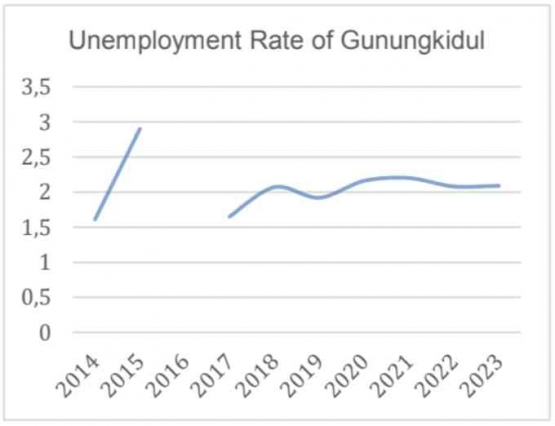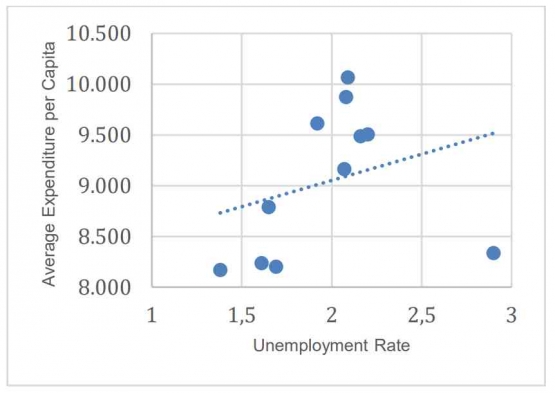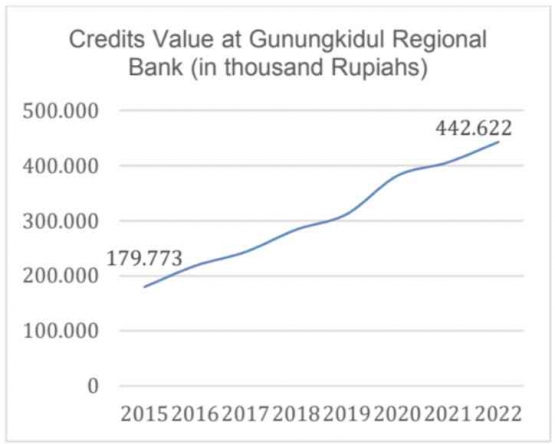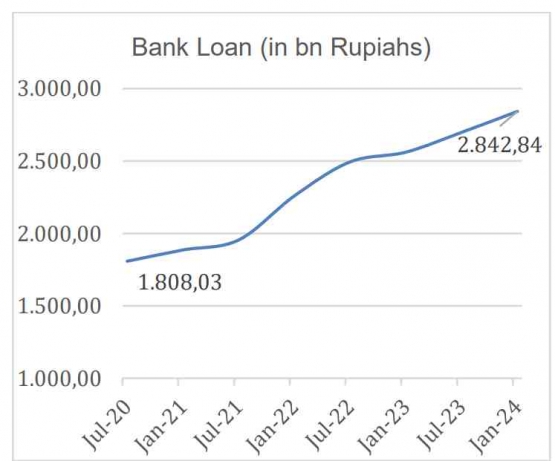"I was in my lowest, hopeless, and desperate for jobs," said Sugeng, survivor of suicide attempt. He does not believe in Pulung Gantung and all the myths that are haunting them. He attempted suicide due to being unemployed and living under the suffocating poverty for so long (BBC News Indonesia, 2017). Being the least developed economy in DIY, many people in Gunungkidul live under the tightening grip of financial issues, such as poverty, unemployment, and debts.

From the figure, we are able to see that there is a low positive correlation between suicide cases and unemployment rate, with a Pearson Correlation Coefficient ( r ) of 0,421. This indicates that the higher the number of unemployed labors, the higher the suicide cases are. Employment status is one of the most crucial factors that contributes to individual's well-being. The theoretical framework of Jahoda's states that unemployment deteriorates health by depriving people of their manifest (e.g., income and monetary rewards) as well as latent (e.g., time structures, social networks, social identity, self-realization, activity, and participation in group endeavors) functions of employment (Kim & von dem Knesebeck, 2016). Being unemployed creates limitation in individual's ability to earn. In 2023, 2,09% of Gunungkidul's labor force do not have jobs and are lacking in income. The lack of income will affect their ability to purchase goods and services that are essential for their well-being. 

Figure 1.5 shows that the higher the unemployment rate is, the higher people in Gunungkidul spend on consumption. Now, using ceteris paribus assumption, this should not be the case. This indicates that there is a relatively increasing inequality in income. There are significant disparities in income among people in Gunungkidul. The widening gap between high and low-income individuals indicates that those with higher income can afford more consumption, while those with lower to no income are struggling to meet their basic needs and become marginalized community. This trend is confirmed by the rising gini ratio. Income inequality worsens as the coefficient gini rises. This marginalized community is living near or below poverty line and later would look for other alternative to fulfil their needs; borrowing money. 

Data shows that the credits value of people living in Gunungkidul is rising over the years. CEIC Data recorded that Gunungkidul's Bank Loan has reached Rp 2.842,84 billion in the starting of 2024 while BPS recorded the Credits Value at Gunungkidul has increased by Rp 262.849 million in the span of 7 years, from regional bank and formal bank alone. Those who borrow from loan shark and informal lenders are excluded. This rising loan indicates that borrowing money has become their survival strategy when there is not enough earnings to meet their basic needs.
However, borrowing money leads them to the cycle of debt and vulnerability, especially those who borrowed from informal lenders. Informal lenders or shark loan usually give immediate fund with high interest rate. As debt accumulates, borrowers will struggle to pay off the principle debts as well as the unreasonably high interest, thus they will borrow more money from another informal lenders to pay off existing debt, creating a vicious cycle of debt. This cycle put borrowers in a vulnerable situation, it hindered upward mobility. They will stay in poverty since their earnings are used to pay off debt instead of essential expenses and savings. This cycle continues until they could no longer pay it off no more.
Unemployment and the lack of income leads the marginalized community to be trapped in debt. The inability to pay off formal or informal debt leads them to despair. The stress from being unable to earn enough may cause anxiety, hopelessness, and depression, which eventually encourage people to commit suicide.
Financial issues often lead to depression and other mental illnesses. There is a negative correlation between the rates of depression, anxiety, and suicide and employment and income. People with the lowest earnings experience depression, anxiety, and other common mental diseases 1.5 -- 3 times more commonly than people with the highest incomes (Ridley et al., 2020).
Other Factors

















